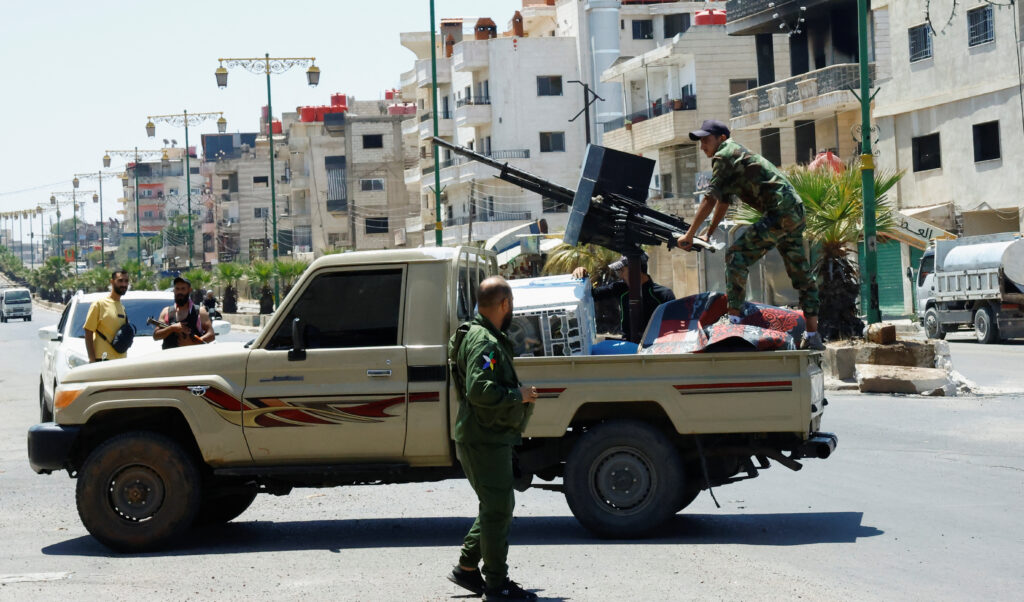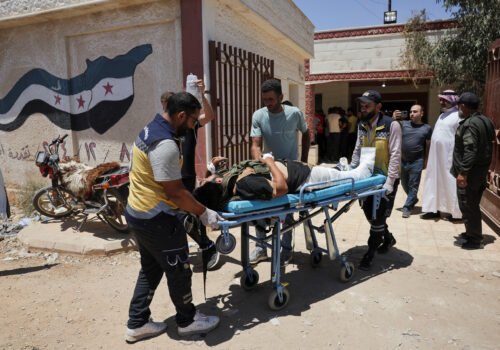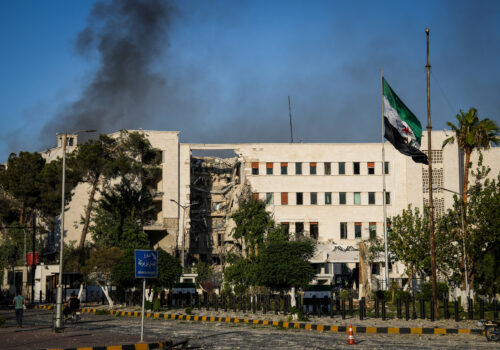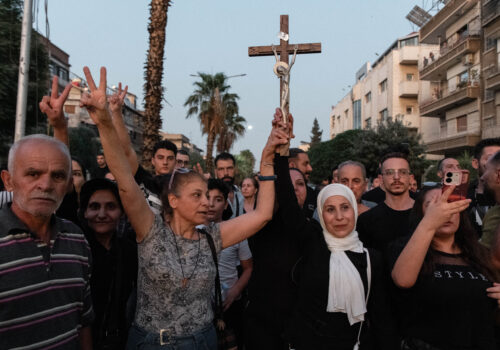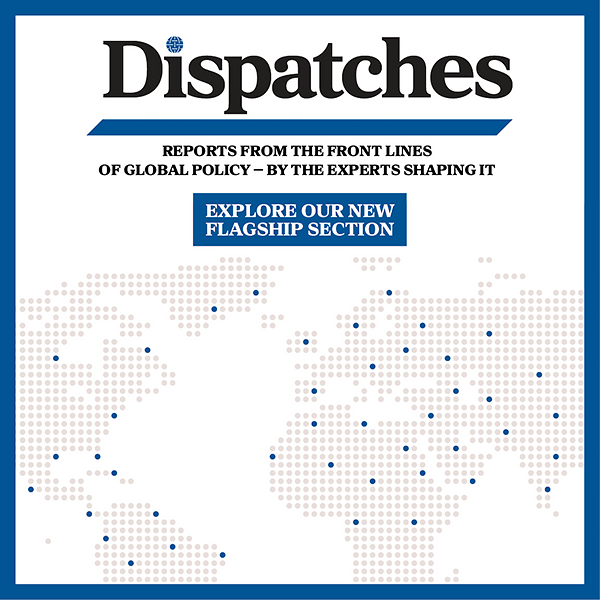DAMASCUS—The sectarian bloodshed that has erupted in Swaida is not just a local conflict, but a disruption of the geopolitical logic of a post-Bashar al-Assad regime Syria.
The clashes between Druze groups and government-aligned militias mark a deeper shift in both internal power dynamics and regional alignments. In mid-July, violence erupted across the Swaida province after armed groups linked to the Syrian government—many composed of Bedouin and tribal fighters—launched coordinated attacks on Druze areas. Some attackers reportedly filmed themselves as they opened fire on civilians, turning the assault into a display of impunity and provocation. What followed was the deadliest outbreak of violence the province has witnessed in years, leaving dozens dead and entire neighborhoods bearing the scars of conflict—bullet-ridden walls, burned-out villages and homes, and families mourning their losses in silence.
As Druze fighters pushed back, thousands of Bedouin civilians were displaced to nearby villages, and a fragile truce was eventually brokered. Yet beneath the fragile truce, the strategic calculations and social contract that once kept Swaida insulated from Syria’s wider conflict have begun to unravel, raising new questions about the province’s future role in the country’s fractured landscape.
Yet Swaida’s unraveling is not only a symptom of Syria’s internal disintegration, it is also a reflection of shifting regional strategies. Regional actors have not merely responded to the Swaida events; they have helped shape them. Israel’s expanding role in the south, Turkey’s strategic alignment with Damascus, and Saudi and Jordanian backing for centralized control reflect evolving geopolitical calculations. Swaida has crystallized the country’s fragmentation into zones of political and military autonomy, pushing Syria further toward a model of disconnected governance centers, shaped as much by foreign alliances as by local legitimacy, or the absence of it.
SIGN UP FOR THIS WEEK IN THE MIDEAST NEWSLETTER
Internally, Swaida’s unfolding crisis underscores how local power vacuums are reshaping Syria’s political geography. Unlike the coast—where President Ahmed al-Sharaa has, at least for now, maintained formal authority and prevented further unrest after a wave of sectarian massacres that targeted Alawites in March, after an anti-government ambush on government forces—Swaida has bucked the trend. Following Israeli airstrikes on Syrian forces in and around Swaida in defense of the Druze, alongside a direct strike on the Syrian army’s headquarters in central Damascus, the United States, Turkey, and several Arab countries brokered a truce between factions. It announced last week a halt to most of the fighting.
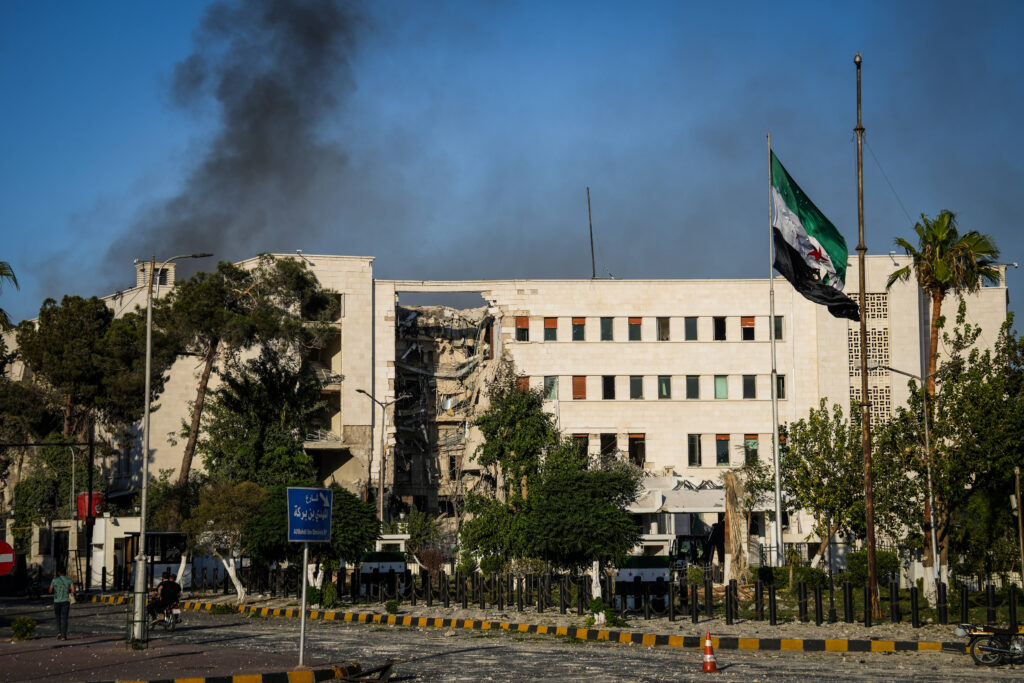
The cease-fire, along with the subsequent withdrawal of Syrian government forces and widespread public outrage over recent killings, has elevated Sheikh Hikmat al-Hajri, the spiritual leader of Syria’s Druze community. Though previously a controversial figure who competed with other Druze religious authorities and led a politically divided community, al-Hajri has now emerged as its most popular voice. He is increasingly seen as the figure who secured Israeli protection and helped prevent the continuation of what many feared would become a massacre at the hands of tribal and government-aligned fighters, earning him hero status among large segments of the Druze population. In a dramatic departure from past caution, broad elements of the Syrian Druze community are now openly signaling a willingness to accept security guarantees from external actors, including Israel, underscoring the depth of the local shift in perception toward Damascus.
This new dynamic has lowered the likelihood of a Syrian-Israeli understanding that, until recently, many believed was within reach. At the same time, the shifting Druze perception of Israel has raised the prospect of a buffer zone emerging inside Syria between Israel and Damascus—further complicating the regime’s strategic calculus. Yet outside of Swaida, Syrian perceptions of Israel have also hardened. Many Syrians I spoke with now view Israel as a force seeking to dismantle the country and extinguish any hope for peace, reconciliation, or a path out of Syria’s long war.
The Swaida crisis has also laid bare the diverging interests of regional actors, each recalibrating their approach to Syria’s future. Israel, more than any other player, has directly shaped the dynamics on the ground. By targeting Syrian heavy weaponry in the south, warning Damascus against introducing new equipment, and siding with Druze armed groups, Israel is turning the notion of a buffer zone inside Syrian territory into a strategic reality. This approach reflects a broader Israeli strategy: keeping power in Syria contested, deterring centralization by actors it cannot control, and countering Iranian resurgence.
Jordan, by contrast, views Swaida’s potential autonomy as a serious security threat. Although the province borders Jordan, there is no formal crossing between the two. Amman remains alarmed by the emergence of an enclave it cannot trust, influence, or regulate—especially one that may align with Israel. Drug and weapons smuggling, already a source of tension, has further escalated concerns, particularly as tribal networks inside Jordan intersect with the conflict dynamics in southern Syria. Jordan has long preferred working with centralized states and has consistently opposed non-state actors and autonomous aspirations near its borders.
Saudi Arabia, meanwhile, has backed Damascus’s efforts to reassert control in Swaida, seeing the preservation of Syria’s territorial integrity as essential to regional stability by preventing Iran’s return to Syria and further chaos in the Levant. Like Turkey and Jordan, Riyadh opposes fragmentation—and has expressed frustration over Israel’s expanding role in the south, a rare moment of convergence between Saudi Arabia and its regional competitor, Turkey.
However, Saudi Arabia remains skeptical of Turkish influence over Damascus, a concern that has motivated Riyadh to increase its support for al-Sharaa in an effort to keep him anchored in the Arab fold. Riyadh certainly recognizes that intensified Israeli attacks on Damascus could drive the Syrian government closer to Ankara, potentially resulting in a growing Turkish military presence across Syria as a counterweight to Israeli pressure—an outcome Riyadh is eager to avoid. Their concern is not only about Syria falling further under Turkish influence, but also about the potential for a Turkish-Israeli confrontation that could further destabilize an already fragile regional landscape.
Nowhere is the strategic divergence in Syria more apparent than between Israel and Turkey. While both states remain deeply invested in shaping outcomes on the ground, their visions for Syria’s future are increasingly at odds.
Israel is working to keep power fragmented, viewing decentralization as a safeguard against centralization by Islamist groups or the rise of an unpredictable coalition that may renege on its commitments in the future. Israel’s approach in Swaida mirrors its broader strategy: empowering localized actors and containing nearby threats through military interventions.
Turkey, by contrast, has thrown its weight behind the central government in Damascus, offering diplomatic support and expanding economic cooperation. Ankara sees al‑Sharaa’s leadership as a bulwark against the US-supported Syrian Democratic Forces (SDF), which Turkey views as an extension of the recently dismantled Kurdistan Workers’ Party (PKK)—a group it designates as a terrorist organization. Ankara believes that a reinvigorated Syrian state—especially one it can influence—is the most effective way to suppress momentum for Kurdish autonomy, and reduce US support for Kurdish forces near its southern border. Turkey also fears that Kurdish factions in Syria may exploit the unrest in the south to mobilize politically and militarily, using the distraction to further their aspirations for self-rule.
While Israel and Turkey have cautiously reopened diplomatic channels with each other, Syria remains a core point of friction. The two sides differ not only on the legitimacy of al‑Sharaa’s rule but also on what political system is required in Syria to maintain stability and regional security. In effect, Israel is fostering fragmentation as a form of security, while Turkey seeks centralization as a path to a stable Syria that does not export Kurdish security challenges. This divergence is likely to deepen as both countries seek to shape the post-conflict order on their own terms.
For the Syrian government under al‑Sharaa, the Swaida crisis has both exposed its limitations and clarified its regional alignment. Control over Swaida remains, for now, a remote possibility. The regime lacks both the legitimacy and the military capacity to reassert itself in the south without triggering broader resistance. Instead, al‑Sharaa is leaning diplomatically on regional backers—particularly Turkey, Jordan, Saudi Arabia, and Qatar—to reinforce his claim to authority and present the state as the only viable guarantor of territorial integrity. His strategy avoids direct negotiation with emerging local leaders like al-Hajri, signaling a refusal to legitimize any actor operating outside formal institutions.
The sole exception remains the SDF, whose US backing necessitates special engagement. But even there, the government resists treating the SDF as a political equal, preferring to limit dialogue to matters of security coordination rather than constitutional or territorial reform. More broadly, al‑Sharaa’s diplomatic playbook prioritizes foreign capitals over domestic consensus—engaging Washington, Ankara, and Tel Aviv, while avoiding any internal conversation about Syria’s future governance. It is a strategy designed to preserve the façade of statehood, even as the state’s internal cohesion continues to erode.
What comes next in Syria will not be determined by battlefield victories or summit declarations, but by the evolving realities on the ground—and the willingness of regional and international actors to adapt to them. The Swaida crisis has marked the formal end of the binary conflict that once defined Syria and shaped events on the coast: regime versus opposition. In its place is a layered, decentralized reality shaped by shifting alliances, overlapping spheres of influence, and competing claims to legitimacy. Syria has emerged from Assad’s decades-long rule not as a single, governable entity, but as a fragmented landscape of semi-autonomous zones, foreign-brokered arrangements, and disconnected governance centers.
For the United States and others, the challenge now is to move beyond outdated frameworks that prioritize state cohesion over political viability. Legitimacy, local consent, and regional coordination—not force or formal recognition alone—will define the next phase of Syria’s transition. Stabilizing Syria will require a broader regional understanding, one that acknowledges the role of neighboring states in shaping outcomes and prevents escalation between them. With Israel increasingly asserting itself militarily inside Syria, the risk of a re-regionalized conflict is growing—a scenario that must be avoided. Whether the goal is stability, reconstruction, or conflict prevention, any serious policy must begin with the recognition that Syria’s center will not hold—and that its peripheries are where the country’s future is being decided.
Ibrahim Al-Assil is a resident senior fellow for the Syria Project at the Atlantic Council’s Middle East Programs. He is also a professorial lecturer at George Washington University’s Department of Political Science, where he teaches courses on comparative politics and great-power competition.
Further reading
Tue, Jul 22, 2025
Why the violence in my hometown, Swaida, goes beyond ‘rivalry.’
MENASource By
US officials described the events as “a rivalry” between Syria's Druze and Bedouins. But this framing strips the crisis of its historical and political context.
Wed, Jul 16, 2025
Five questions (and expert answers) about Israel’s strikes against Syria
New Atlanticist By
Our Middle East experts explain the roots of the crisis and what it means for Syria, Israel, the Druze, and the broader region.
Thu, Jun 26, 2025
Dispatch from Damascus: Church attack shows transition’s fragility
MENASource By Ibrahim Al-Assil
The bombing at Mar Elias Church is more than an isolated tragedy. It is a signal that Syria’s transition remains vulnerable to sabotage.
Image: A person wearing military clothing stands at the back of a vehicle, following deadly clashes between Druze fighters, Sunni Bedouin tribes and government forces, in Syria's predominantly Druze city of Sweida, Syria July 25, 2025. REUTERS/Yamam al Shaar
